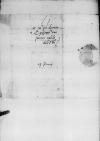List #1858
Bona Sforza do Ioannes DANTISCUSCracow (Kraków), 1538-05-24
| odebrano [1538]-06-02 Rękopiśmienne podstawy źródłowe:
| ||||
Tekst + aparat krytyczny + komentarzZwykły tekstTekst + komentarzTekst + aparat krytyczny
Reverendo paper damaged⌈[Reverendo]Reverendo paper damaged⌉ in Christo Patri, domino
Reverende in Christo Pater, sincere nobis dilecte.
Adversam valetudinem Paternitatis Vestrae doluimus, restitutam autem pristinae sanitati gaudemus plurimum, ut enim fortunarum Paternitatis Vestrae auctrices fuimus, ita illam diu valere et ipsis fortunis frui feliciter ex animo cupimus.
Quid geratur in
Bene valeat.
Dat(ae) or Dat(um)⌈Dat(ae)Dat(ae) or Dat(um)⌉
Ad mandatum s(acrae) or s(erenissimae)⌈s(acrae)s(acrae) or s(erenissimae)⌉ maiestatis reginalis proprium


 BCz, 1601, p. 670
BCz, 1601, p. 670